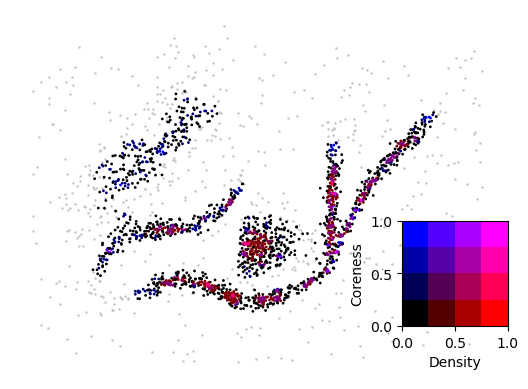Hierarchical Boundary Coefficient Clustering (HBCC)
HBCC is a boundary-based clustering algorithm based on the intuition that: (1) points within a clusters have near neighbors on all sides, and (2) points in-between clusters or on the edge of a cluster predominantly have neighbors in the direction of the cluster’s core. Vandaele et al.’s boundary coefficient quantifies this intuition. HBCC interprets the boundary coefficient as a distance, from which it creates a density-like profile. HDBSCAN’s principled density-based cluster extraction
strategies are then used to detect boundary-based clusters.
The relation between the boundary coefficient and local density is not completely clear yet. Their main difference is that density only considers how far away neighbors are, while the boundary coefficient also considers how spread out they are. Typically, local density maxima occur towards the center of a cluster (due to some Gaussian-like spread around a true centre). In that case, the boundary coefficient agrees, neighbors are spread out around the local density maximum. However, the boundary coefficient can have local minima in places where there is not density maximum, allowing it to detect clusters that are not detectable using density-based clustering.
To demonstrate this, consider a three-point star in which density decrease along its arms:
[ ]:
%load_ext autoreload
%autoreload 2
[101]:
import numpy as np
import matplotlib.tri as mtri
import matplotlib.pyplot as plt
from scipy import linalg
from fast_hbcc import HBCC
from fast_hdbscan import HDBSCAN
from sklearn.utils import shuffle
[102]:
def make_star(num_samples=100, length=2, scale=0.02):
"""Creates a star with three branches.
Datapoints are spaced logarithmically along the branch length,
with the high-density part at the start of the branches.
"""
def rotation(axis=[0, 0, 1], theta=0):
return linalg.expm(np.cross(np.eye(3), axis / linalg.norm(axis) * theta))
def rotate(X, axis=[0, 0, 1], theta=0):
M = rotation(axis=axis, theta=theta)
data = np.hstack((X, np.zeros((X.shape[0], 1), dtype=X.dtype)))
return (M @ data.T).T[:, :2]
max_exp = np.log(length)
x = np.exp(np.linspace(0, max_exp, num_samples)) - 1
branch = np.hstack((x[None].T, np.zeros((x.shape[0], 1), dtype=x.dtype)))
X = np.vstack(
(
rotate(branch, theta=np.pi / 2),
rotate(branch, theta=2 * np.pi / 3 + np.pi / 2),
rotate(branch, theta=4 * np.pi / 3 + np.pi / 2),
)
)
X += np.random.normal(scale=scale, size=X.shape)
y = np.repeat([0, 1, 2], num_samples)
X, y = shuffle(X, y)
return X, y
X, y = make_star(length=1.5, scale=0.1 * np.sqrt(1 / 2))
X = np.concat((X, X + np.array([1.2, 0])))
y = np.concat((y, y + y.max() + 1))
kwargs = dict(s=16, cmap="tab10", vmin=0, vmax=9)
plt.scatter(*X.T, c=y, **kwargs)
plt.axis("equal")
plt.axis("off")
plt.show()
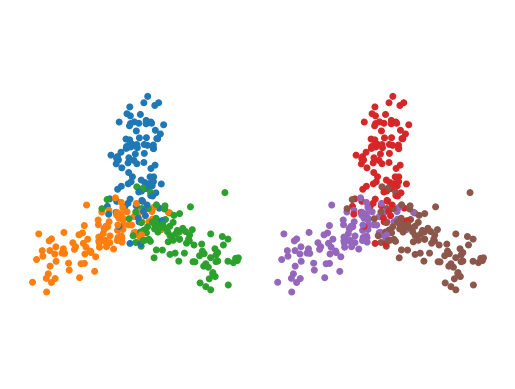
Density-based clusters
Density-based clustering algorithms, like HDBSCAN, create a density-profile of the data expressing how dense each part of the data space is. We show this density profile in a 3D plot, where peaks correspond to high density values.
[103]:
hdbscan = HDBSCAN(min_cluster_size=45, cluster_selection_method="leaf").fit(X)
density = 1 / hdbscan._core_distances
[104]:
fig = plt.figure(figsize=(6, 3))
tri = mtri.Triangulation(X[:, 0], X[:, 1])
ax = fig.add_subplot(1, 1, 1, projection="3d", computed_zorder=False)
ax.view_init(elev=30, azim=-110)
ax.scatter(
X[:, 0],
X[:, 1],
np.repeat(density.min(), X.shape[0]),
s=1,
alpha=1,
edgecolor="none",
linewidth=0,
)
ax.tricontour(
tri,
density,
levels=np.exp(np.linspace(np.log(3.5), np.log(density.max()), 15)),
cmap="cividis",
)
ax.set_xticklabels([])
ax.set_yticklabels([])
ax.set_zticklabels([])
xlim = ax.get_xlim()
ylim = ax.get_ylim()
zlim = ax.get_zlim()
ax.set_box_aspect(aspect=(3, 3, 1.5))
plt.subplots_adjust(-0.1, -0.1, 1.1, 1.1)
plt.show()
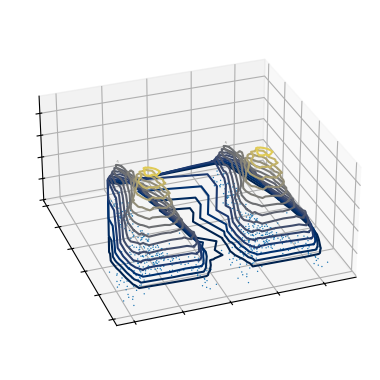
Then, density-based algorithms create a cluster hierarchy. Imagine a plane sliding down over the density-profile. The cluster hierarchy describes how the peaks that poke through the plane merge as the plane slides down, forming a join tree. HDBSCAN calls this hierarchy the condensed_tree and provides a good plot for it. Notice that it plots density downward instead of upward!
[105]:
hdbscan.condensed_tree_.plot()
plt.show()
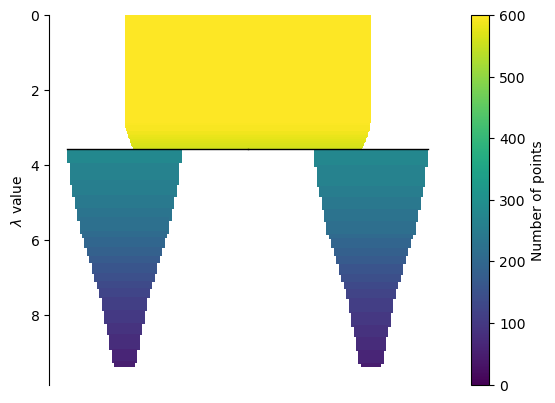
The density-profile and condensed tree plot show that density-based clustering algorithm (in general) cannot detect this branching pattern. This is true for all branching patterns in which the branches are not separated from the cluster by a low density region and in which the branches do not contain a local density maximum. In other words, branching patterns do not conform to the definition of a cluster that density-based clustering algorithms use to detect clusters.
As a result, HDBSCAN finds the two stars as clusters, and ignores the branches:
[145]:
plt.figure(figsize=(6, 2))
plt.subplot(1, 2, 1)
plt.scatter(*X.T, c=hdbscan._core_distances, s=15)
plt.axis("equal")
plt.axis("off")
plt.subplot(1, 2, 2)
plt.scatter(*X.T, c=hdbscan.labels_ % 10, **kwargs)
plt.axis("equal")
plt.axis("off")
plt.subplots_adjust(left=0, right=1, top=1, bottom=0, wspace=0, hspace=0)
plt.show()

Boundary-based clusters
Clustering on a profile created from the boundary coefficient does find the branches, as that profile contains local maxima within the branches:
[141]:
hbcc = HBCC(
num_hops=4,
min_samples=10,
min_cluster_size=20,
cluster_selection_method="eom",
).fit(X)
coreness = 1 / hbcc.boundary_coefficient_
[142]:
fig = plt.figure(figsize=(12, 3))
ax = fig.add_subplot(1, 1, 1, projection="3d", computed_zorder=False)
ax.view_init(elev=30, azim=-110)
ax.scatter(
X[:, 0],
X[:, 1],
np.repeat(coreness.min(), X.shape[0]),
s=1,
alpha=1,
edgecolor="none",
linewidth=0,
)
ax.tricontour(
tri,
coreness,
levels=np.exp(np.linspace(np.log(1), np.log(coreness.max()), 20)),
cmap="cividis",
)
ax.set_xticklabels([])
ax.set_yticklabels([])
ax.set_zticklabels([])
xlim = ax.get_xlim()
ylim = ax.get_ylim()
zlim = ax.get_zlim()
ax.set_box_aspect(aspect=(3, 3, 1.5))
plt.subplots_adjust(-0.1, -0.1, 1.1, 1.1)
plt.show()
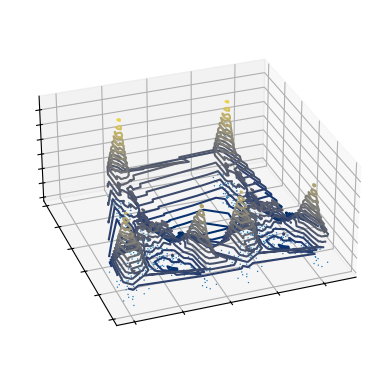
As a result, the cluster hierarchy also captured the branches.
[143]:
hbcc.condensed_tree_.plot()
plt.ylabel('$1 / bc$')
plt.ylim([1.5, 1])
plt.show()
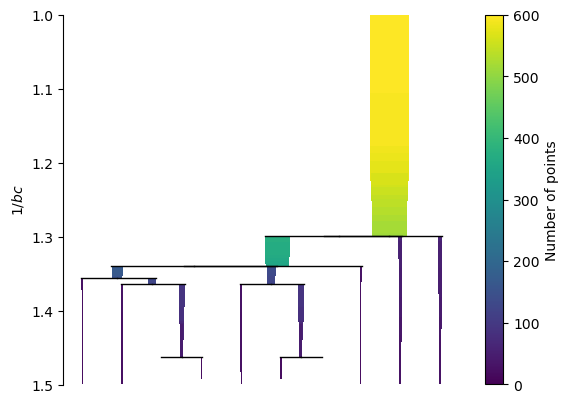
And the branches can be selected as clusters:
[144]:
plt.figure(figsize=(6, 2))
plt.subplot(1, 2, 1)
plt.scatter(*X.T, c=hbcc.boundary_coefficient_, s=15)
plt.axis("equal")
plt.axis("off")
plt.subplot(1, 2, 2)
plt.scatter(*X.T, c=hbcc.labels_ % 10, **kwargs)
plt.axis("equal")
plt.axis("off")
plt.subplots_adjust(left=0, right=1, top=1, bottom=0, wspace=0, hspace=0)
plt.show()
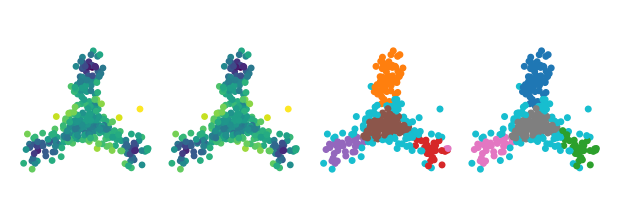
Limitations: Noise Rejection
Detecting noise points is less effective when using the boundary coefficient in place of core distances. CDC [4], the algorithm that inspired HBCC, addressed this issue by running a noise-detection pre-processing step. HBCC does not have such a step (yet). As a result, noise points can form clusters or create connections between clusters in more complicated datasets.
[146]:
data = np.load("data/flareable/flared_clusterable_data.npy")
[147]:
c = HBCC(min_cluster_size=100, cluster_selection_method="leaf").fit(data)
kwargs["s"] = 2
plt.scatter(*data.T, c=c.labels_ % 10, **kwargs)
plt.axis("off")
plt.show()

Tuning the boundary coefficient parameters can improve results. However, the interaction between num_points and min_samples can be difficult to predict. Both parameters influence the position and presence of local maxima in the boundary coefficient profile. Generally, higher values result in a smooth profile, which creates fewer, larger clusters.
[148]:
hops = [2, 4, 6]
samples = [2, 5, 10]
kwargs["s"] = 1
plt.figure(figsize=(8, 6))
cnt = 1
for samples in samples:
for hop in hops:
c = HBCC(
num_hops=hop,
min_samples=samples,
min_cluster_size=100,
cluster_selection_method="leaf",
).fit(data)
plt.subplot(3, 3, cnt)
if samples == 2:
plt.title(hop)
if hop == 2:
plt.ylabel(samples)
plt.scatter(*data.T, c=c.labels_ % 10, **kwargs)
plt.xticks([])
plt.yticks([])
cnt += 1
plt.text(
0,
0.5,
"Min. samples",
rotation=90,
va="center",
ha="center",
transform=plt.gcf().transFigure,
)
plt.text(
0.5,
1,
"Num. hops",
va="center",
ha="center",
transform=plt.gcf().transFigure,
)
plt.subplots_adjust(left=0.05, top=0.95, wspace=0, hspace=0)
plt.show()

Operating on HDBSCAN clusters
Noise can also be rejected by first extracting larger HDBSCAN clusters and computing boundary coefficient sub-clusters within each larger cluster. This approach is also used by FLASC for branch detection and supported by the fast_hdbscan package.
[149]:
from fast_hbcc import BoundaryClusterDetector
[153]:
c = HDBSCAN(min_samples=10, min_cluster_size=40).fit(data)
d = BoundaryClusterDetector().fit(c)
mask = d.labels_ != -1
plt.scatter(*data[~mask].T, c='silver', s=)
plt.scatter(*data[mask].T, c=d.labels_[mask] % 10, **kwargs)
plt.axis("off")
plt.show()
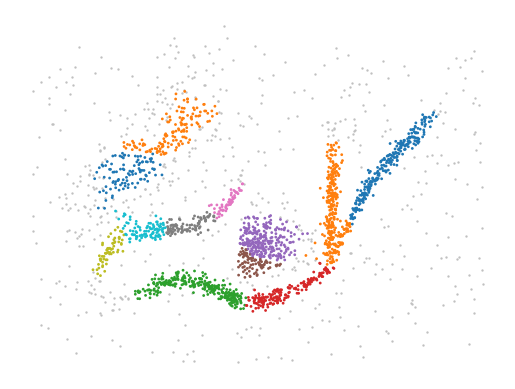
Comparing the density and coreness profiles indicates that the boundary coefficient indeed includes peaks that are not in the density profile. On the other hand, peaks in the density profile tend to also exist in the coreness profile, albeit with a less pronounced peak.
[201]:
density = 1 / c._core_distances
with np.errstate(divide="ignore", invalid="ignore"):
coreness = 1 / d.boundary_coefficient_
coreness = np.where(np.isinf(coreness), 0, coreness)
titles = ["Density", "Coreness"]
profiles = [density, coreness]
min_contour = [20, 0.1]
tri = mtri.Triangulation(data[:, 0], data[:, 1])
fig = plt.figure(figsize=(6, 3))
for i, (title, profile, min_c) in enumerate(zip(titles, profiles, min_contour)):
ax = fig.add_subplot(1, 2, 1 + i, projection="3d", computed_zorder=False)
plt.title(title)
ax.view_init(elev=50, azim=-110)
ax.scatter(
data[:, 0],
data[:, 1],
np.repeat(profile.min(), data.shape[0]),
s=1,
alpha=1,
edgecolor="none",
linewidth=0,
)
ax.tricontour(
tri,
profile,
levels=np.exp(np.linspace(np.log(min_c), np.log(profile.max()), 20)),
cmap="cividis",
)
ax.set_xticklabels([])
ax.set_yticklabels([])
ax.set_zticklabels([])
xlim = ax.get_xlim()
ylim = ax.get_ylim()
zlim = ax.get_zlim()
ax.set_box_aspect(aspect=(3, 3, 1.5))
plt.subplots_adjust(-0.1, -0.1, 1.1, 1.1)
plt.show()
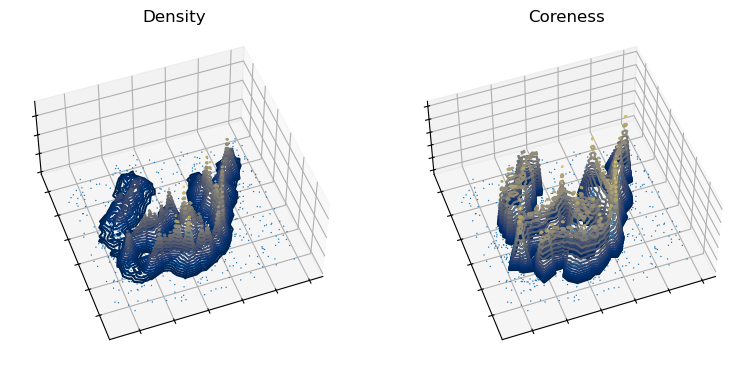
Drawing the difference between the (normalized) profiles in color is slightly easer to read. The blue points represent peaks in the coreness profile that do not exist in the density profile. Red points indicate the opposite pattern.
[259]:
from matplotlib.colors import BoundaryNorm
def normalise(x):
i = x.min()
a = x.max()
return (x - i) / (a - i)
n_density = normalise(density[mask])
n_coreness = normalise(coreness[mask])
norm = BoundaryNorm(np.linspace(0, 1, 4), 256)
fig = plt.figure()
plt.scatter(*data[~mask].T, c="silver", s=0.5)
plt.scatter(
*data[mask].T,
c=[(norm(d) / 256, 0, norm(c) / 256) for d, c in zip(n_density, n_coreness)],
s=1
)
plt.axis("off")
fig.add_axes([0.72, 0.22, 0.2, 0.22])
X, Y = np.meshgrid(np.linspace(0, 1, 4), np.linspace(0, 1, 4))
Z = np.concat((X[:, :, None], np.zeros_like(X)[:, :, None], Y[:, :, None]), axis=2)
plt.imshow(Z, extent=(0, 1, 0, 1), origin="lower")
plt.xlabel("Density")
plt.ylabel("Coreness")
plt.show()
